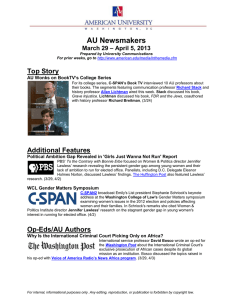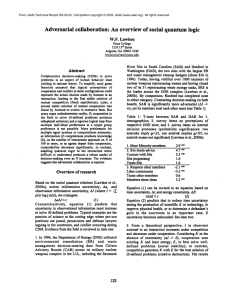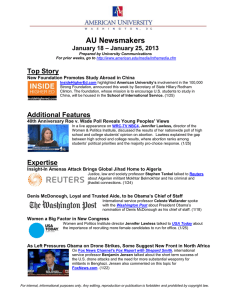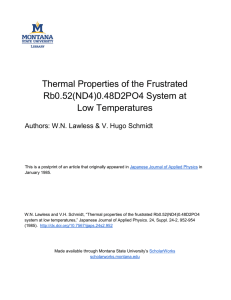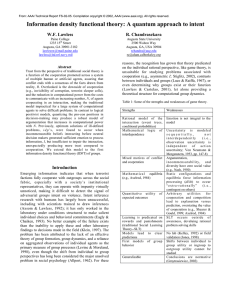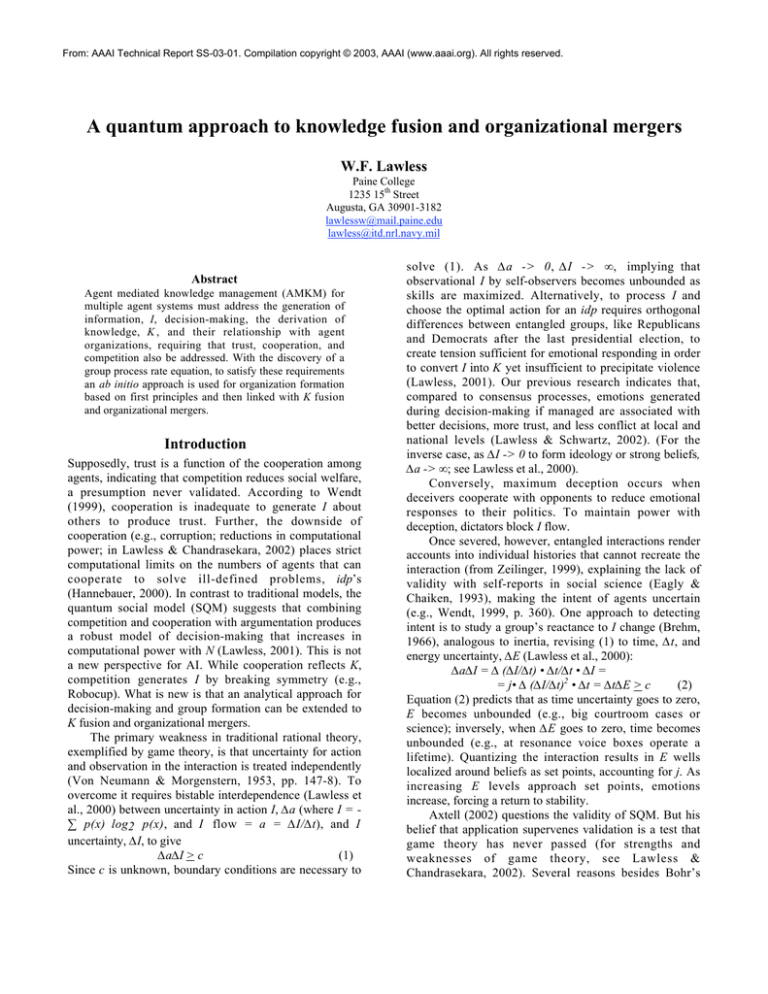
From: AAAI Technical Report SS-03-01. Compilation copyright © 2003, AAAI (www.aaai.org). All rights reserved.
A quantum approach to knowledge fusion and organizational mergers
W.F. Lawless
Paine College
1235 15th Street
Augusta, GA 30901-3182
lawlessw@mail.paine.edu
lawless@itd.nrl.navy.mil
Abstract
Agent mediated knowledge management (AMKM) for
multiple agent systems must address the generation of
information, I, decision-making, the derivation of
knowledge, K , and their relationship with agent
organizations, requiring that trust, cooperation, and
competition also be addressed. With the discovery of a
group process rate equation, to satisfy these requirements
an ab initio approach is used for organization formation
based on first principles and then linked with K fusion
and organizational mergers.
Introduction
Supposedly, trust is a function of the cooperation among
agents, indicating that competition reduces social welfare,
a presumption never validated. According to Wendt
(1999), cooperation is inadequate to generate I about
others to produce trust. Further, the downside of
cooperation (e.g., corruption; reductions in computational
power; in Lawless & Chandrasekara, 2002) places strict
computational limits on the numbers of agents that can
cooperate to solve ill-defined problems, idp’s
(Hannebauer, 2000). In contrast to traditional models, the
quantum social model (SQM) suggests that combining
competition and cooperation with argumentation produces
a robust model of decision-making that increases in
computational power with N (Lawless, 2001). This is not
a new perspective for AI. While cooperation reflects K,
competition generates I by breaking symmetry (e.g.,
Robocup). What is new is that an analytical approach for
decision-making and group formation can be extended to
K fusion and organizational mergers.
The primary weakness in traditional rational theory,
exemplified by game theory, is that uncertainty for action
and observation in the interaction is treated independently
(Von Neumann & Morgenstern, 1953, pp. 147-8). To
overcome it requires bistable interdependence (Lawless et
al., 2000) between uncertainty in action I, ∆a (where I = ∑ p(x) log2 p(x), and I flow = a = ∆I/∆t), and I
uncertainty, ∆I, to give
∆a∆I > c
(1)
Since c is unknown, boundary conditions are necessary to
solve (1). As ∆a -> 0, ∆I -> ∞, implying that
observational I by self-observers becomes unbounded as
skills are maximized. Alternatively, to process I and
choose the optimal action for an idp requires orthogonal
differences between entangled groups, like Republicans
and Democrats after the last presidential election, to
create tension sufficient for emotional responding in order
to convert I into K yet insufficient to precipitate violence
(Lawless, 2001). Our previous research indicates that,
compared to consensus processes, emotions generated
during decision-making if managed are associated with
better decisions, more trust, and less conflict at local and
national levels (Lawless & Schwartz, 2002). (For the
inverse case, as ∆I -> 0 to form ideology or strong beliefs,
∆a -> ∞; see Lawless et al., 2000).
Conversely, maximum deception occurs when
deceivers cooperate with opponents to reduce emotional
responses to their politics. To maintain power with
deception, dictators block I flow.
Once severed, however, entangled interactions render
accounts into individual histories that cannot recreate the
interaction (from Zeilinger, 1999), explaining the lack of
validity with self-reports in social science (Eagly &
Chaiken, 1993), making the intent of agents uncertain
(e.g., Wendt, 1999, p. 360). One approach to detecting
intent is to study a group’s reactance to I change (Brehm,
1966), analogous to inertia, revising (1) to time, ∆t, and
energy uncertainty, ∆E (Lawless et al., 2000):
∆a∆I = ∆ (∆I/∆t) • ∆t/∆t • ∆I =
= j• ∆ (∆I/∆t)2 • ∆t = ∆t∆E > c
(2)
Equation (2) predicts that as time uncertainty goes to zero,
E becomes unbounded (e.g., big courtroom cases or
science); inversely, when ∆E goes to zero, time becomes
unbounded (e.g., at resonance voice boxes operate a
lifetime). Quantizing the interaction results in E wells
localized around beliefs as set points, accounting for j. As
increasing E levels approach set points, emotions
increase, forcing a return to stability.
Axtell (2002) questions the validity of SQM. But his
belief that application supervenes validation is a test that
game theory has never passed (for strengths and
weaknesses of game theory, see Lawless &
Chandrasekara, 2002). Several reasons besides Bohr’s
exist to consider SQM. The brain acts as a quantum I
processor, converting photons hitting the retina into
usable I (French & Taylor, 1978). Unlike the continuous
model of traditional signal detection theory (i.e., ROC
curves), the Bèkèsy-Stevens quanta model is based on
detecting discrete stimulus differences from background,
producing a linear relationship between threshold and
saturation (Luce, 1997). The dichotomous choices in
decision making have been quantized (e.g., Eisert et al.,
1999). And evidence for the validity of (2) comes from
Penrose (Hagan et al., 2002): if the brain is one unit and c
Planck’s constant, h, then ∆E∆t = ∆(h w /2$)∆t > h/2$
reduces to ∆w∆t > 1. Choosing w for brain gamma waves
(≈40 Hz) associated with object awareness gives a
reasonable minimum ∆t of 25 ms (Crick & Koch, 1998).
SQM has been extended to approximate the function
of I density and discrete E effects in an organization from
adding or removing members. A group forms or reforms
by entangling I from an aggregation of individuals to
solve an idp, like designing a complex weapon (Ambrose,
2001). The chief characteristic of an idp is that K concepts
do not correspond to objects or actions in reality, R. Once
solved, however, an idp becomes a well-defined problem,
wdp, characterized by a correspondence between K, skills
and R (Sallach, 2002), and by cooperation and low I
density. In the solution of wdp’s, individuals function in
roles bonded into a stable network oriented by a shared
emotional potential E field, E PES, representing function,
hierarchy and geo-cultural differences across an
organization:
EPES (x,y) = minz,R-org ETOT (x,y,z,Rorg)
(3)
A recruit moves across the E surface, Rorg, where ETOT is
the ground state and PES the minimum total E along the z
coordinate of the organizational configuration (hierarchy)
until reaching a minima. Its growth rate for different
processes, P, like diffusing or adsorbing recruits, gives
GP = nAnB a sAB exp (-∆A/kBT)
(4)
where nA and nB are the numbers of recruits and leaders; a
= ∆I/∆t; sAB is the cross-sectional area, ac, times the
vocal frequency of leaders, w0, and recruits, w, increasing
as language “matches” resonate, giving ac (w 4/(w2w02)2)); and with k B as Boltzman’s constant and T
emotional temperature (T = ∂E/∂I), exp (•) becomes the
probability for interaction, decreasing with the increasing
free E required, ∆A, increasing for rising T.
Once a bond forms between two members, A and B,
the ground E state of the group is less than the aggregate
of its members, the difference being the binding E , W,
calculated from the configuration of barriers and nearest
and next-nearest neighbors. The E required to reverse the
process and break apart the group becomes ∆A + W.
Assuming that two recruits (A) bind to one another and to
one leader (B), the Hamiltonian consists of a site
contribution, H0, plus an interaction term, H int (for details,
see Lawless & Chandrasekara, 2002).
As an aggregate of individuals with independent sets
of beliefs begins to interact, arousal first increases then
reduces over time to a joint E ground state as interactions
serve the group and stabilize, forming interdependent
emotional fields that orient shared K and skills to
correspond with R , the amount of effort (training)
determining E well-depth. Effort expended to convert I
into K, and to recruit, indoctrinate, and train new
members departs from resonance.
While physical T has no analog in social systems,
assuming that T is the average activation experienced in a
social I field (emotion), T affects the strength, f(E), of an
interaction structure, becoming f(E) = 1/(1 + exp(2E/kBT)); as T drops, interaction structures become more
reactant to I change. Baseline T or minimum E occurs at
resonance, the point of greatest cooperation between
agents (see Lawless, 2001). Conversely, as emotion T
increases, I becomes random (increases), causing
organizational bonds to dissipate, illustrating creative
destruction (Schumpeter, 1989).
The USS Vincennes engaged in battle with Iranian
gunboats in 1988 inadvertently shot down an Iranian
Airbus (www.crashdatabase.com), but also illustrating
that the danger of central decision-making is the belief
that there always exists a single rational decision superior
to a democratic solution (Benardete, 2002). That is why
democratic decision-making minimizes operational
mistakes when orthogonal arguments are used to generate
I (alternatives) by strengthening opposing arguments until
neutral decision-makers reach an optimum decision or K
(Lawless & Schwartz, 2002). But to fuse data into K
requires a T sufficient for neutrals to process the
argument, but not so high as to impair the interaction. The
speculation is that the acquisition by neutrals of the
concept being forwarded by one of the discussants
followed by the reverse perception from the second
discussant helps to capture the essence of a problem, and
that a certain number of concept reversals are required to
decide on the solution path, measuring the degree of the
problem and the E required to achieve K fusion.
Andrade and Stafford (1999) noted that mergers from
an excess of profit can reduce social welfare (e.g., gaining
price control across a market) and promote organizational
fragmentation. Senator R. Shelby, Republican, recently
criticized the fragmentation between intelligence
agencies: “We've made some adjustments, but the cultures
have not changed between all the intelligence agencies
making up the community. I don't believe they're sharing
information. There's no fusion, central place yet to do it”
(www.cbsnews.com/sections/ftn). Similar to optimum
decision-making or K fusion, reducing fragmentation in
an organization requires a rise in T to break barriers
between groups.
In contrast, mergers for survival occur in a
consolidating market (e.g., the loss of purchasing power
across a market sector); they are highly threatening,
spontaneously causing a rise in T, but also reducing the
likelihood of cultural clashes; e.g., in past merger plans
between AOL Time Warner’s CNN and Walt Disney’s
ABC News (www.latimes.com), internal conflicts over
star anchors and content control derailed merger talks
meant to help both compete against Fox News; however,
as the plunge in advertising revenue exacerbated, merger
talks resumed. Mergers based on survival are strikingly
similar to slime molds and ants when their environments
are threatened (Nicolis & Prigogine, 1989, pp. 33 and
236).
Conclusion
SQM offers the possibility that an analytical model that
simulates the conjugate aspects of decision-making, I
generation, and organizational growth may also simulate
K fusion and organizational mergers. The major discovery
with SQM is the existence of interaction cross-sections,
suggesting new areas for future research. But SQM also
accounts for differences between an aggregation and a
group constituted of the same individuals, succeeding
where game theory has failed (Luce & Raiffa, 1967); it
explains why traditional models based on the individual
perspective of rationality fail (Levine & Moreland, 1998),
why ABM’s cannot be validated (Bankes, 2002), and why
traditional perspectives of cooperation are normative
(Gmytrasiewicz, 2002), rather than scientific. Finally,
with SQM it becomes possible to speculate that during
negotiations as foreseen by Nash (1950) and others but
only when driven by competition, cooperation harnesses
competition to solve idp’s by precluding convergence
(unlike machine intelliqence) until after orthogonal
arguments have been sufficient to promote optimal
mergers of organizations or the production and fusion of
K.
Acknowledgements. The author thanks J.A. Ballas, ITD,
NRL, Washington, DC, where most of this research was
conducted with funds from ONR through an ASEE grant.
References
Ambrose, S.H. (2001), Paleolithic technology and human
evolution, Science, 291, 1748-53.
Andrade, G., & Stafford, E. (1999). Investigating the economic
role of mergers (Working Paper 00-006). Cambridge,
MA, Harvard.
Axtell, R. (2002). Personal communication.
Bankes, S. C. (2002). "Perspective. Agent-based modeling Proc
NAS, 99(3): 7199-7200.
Benardete, S. (2002), The argument of the action: Essays on
Greek poetry and philosophy, Chicago: Chicago U. Press.
Brehm, J.W. (1966). A theory of psychological reactance. New
York: Academic Press.
Crick, F., & Koch, C. (1998). "Consciousness and
neuroscience." Cerebral Cortex 8: 97-107.
Eisert, J., Wilkens, M., & Lewenstein, M. (1999). "Quantum
games and quantum strategies." PRL, 83(15): 3077-3080.
Eagly, A.H. & Chaiken, S. (1993), The psychology of attitudes,
Harcourt: Fort Worth.
French, A. P., & Taylor, E.F. (1978). An introduction to
quantum physics. New York, Norton.
Gmytrasiewicz, P.J. (2002), On decision-theoretic approach to
game theory, SS-02-02, pp. 1-8, Menlo Park, CA: AAAI.
Hagan, S., Hameroff, S.R., & Tuszynski, J.A. (2002). "Quantum
computation in brain microtubles." Physical Review E 65:
061901-1, 11.
Hannebauer, M. (2000), Their problems are my problems, In C.
Tessier, H.J. Muller, & L. Chaudron, Conflicting agents:
Conflict mgt in multi-agent systems, pp. 63-110, Boston:
Kluwer.
Lawless, W.F. (2001), The quantum of social action and the
function of emotion, Proceedings, pp. 73-78, AAAI Fall.
Lawless, W.F. (2002a), The social quantum square well model
of emotion and decision-making, A. Namatame et al.
(Eds), Proc. Complexity with Agent-based Modeling, 6th
International Conference (CS02), pp. 317-324, Tokyo,
Japan, Sep. 9-11, 2002.
Lawless, W.F. (2002b), Adversarial cooperative collaboration:
An overview of social quantum logic, Proceedings
Collaborative learning agents, pp. 122-3, AAAI-2002
Spring Symposium, Stanford University, CA.
Lawless, W.F., Castelao & Abubucker (2000), Conflict, in
Tessier et al., Conflicting agents, pp. 279-302, Kluwer.
Lawless, W.F. & Chandrasekara, R. (2002, forthcoming),
Information density functional theory: A quantum
approach to intent, Proceedings AAAI Fall Conference,
November 15-17, 2002, North Falmouth, MA.
Lawless, W. F., & Schwartz, M. (2002, forthcoming). "The
social quantum model of dissonance." Social Science
Computer Review, Sage.
Levine, J.M. and Moreland, R.L. (1998), Small groups, In
Gilbert et al., Hdbk Soc Psych, pp. 415-469, McGraw.
Luce, R. D. (1997). "Several unresolved conceptual problems of
math psych." J Math Psychology 41: 79-87.
Luce, R.D. and Raiffa, H. (1967), Games and decision, New
York: Wiley.
Nash, J.F., Jr. (1950), The bargaining problem, Econometrica,
18, 155-162.
Nicolis, G., & Prigogine, I. (1989), Exploring complexity, New
York: Freeman.
Sallach, D. (2002), Mod. emotional dyn. (unpub), U. Chicago.
Schumpeter, J.A. (1989), A theoretical, historical, and statistical
analysis of the capitalist process, Porcupine Press.
Von Neumann, J., & Morgenstern, O. (1953). Theory of games
and economic behavior. Princeton U. Press.
Wendt, A. (1999). Social theory of international politics.
Cambridge University Press.
Zeilinger, A. (1999), Experiment and foundations of quantum
physics, Rev. Mod. Physics, 71: S288.

